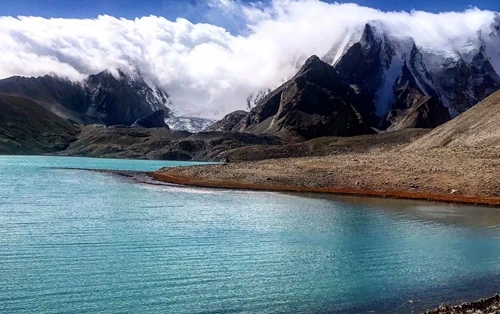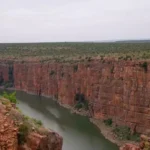Gurudongmar Lake, one of the highest lakes in the world, is a mesmerizing destination in North Sikkim. Located at an altitude of around 17,800 feet, this pristine lake is revered by Buddhists, Hindus, and Sikhs alike, and is surrounded by towering snow-clad mountains and a stunning, serene landscape. Known for its surreal beauty and spiritual significance, Gurudongmar Lake is often called a paradise on earth, drawing visitors from around the globe.
Choosing the best time to visit Gurudongmar Lake is essential to experiencing its breathtaking beauty while navigating the challenges posed by the lake’s high altitude and extreme weather. From crystal-clear views in summer to a snow-covered winter wonderland, each season offers a unique experience for travelers. Here’s a guide to planning your visit to Gurudongmar Lake, helping you make the most of this once-in-a-lifetime journey.

The Sacred Beauty of Gurudongmar Lake
Located just a few kilometers from the Indo-Tibetan border, Gurudongmar Lake is one of Sikkim’s most iconic destinations. Its turquoise-blue waters remain partially unfrozen even in winter, adding a mystical quality to the lake. According to local legend, the lake was blessed by Guru Padmasambhava, a revered figure in Tibetan Buddhism, allowing a section of it to remain unfrozen all year for local communities to access fresh water.
The lake’s remote location, surrounded by the stunning Himalayas, offers a sense of solitude and spirituality that’s hard to find elsewhere. However, given its high altitude, acclimatization is essential for a comfortable experience. The journey to Gurudongmar Lake passes through scenic villages and breathtaking valleys, providing travelers with a glimpse into North Sikkim’s natural beauty and cultural richness.
Best Seasons to Visit Gurudongmar Lake
1. Summer (April to June)
Summer is considered the best time to visit Gurudongmar Lake, as the weather is mild, with temperatures ranging from 5°C to 15°C during the day, though nights can still be chilly. The roads to Gurudongmar Lake are typically open in summer, making travel easier and safer compared to other seasons. The sky is usually clear, allowing visitors to enjoy uninterrupted views of the lake’s crystal-blue waters against a backdrop of snow-capped mountains.
During summer, the landscape around the lake is vibrant and filled with blooming wildflowers, creating a stark contrast to the rocky terrain. The journey to Gurudongmar Lake from Lachen (the nearest village with accommodation) is relatively smooth in this season, and visitors can take their time appreciating the scenic beauty along the way.
If you’re planning a summer visit, it’s advisable to start your journey from Lachen early in the morning to reach the lake before noon. As the altitude is high, the oxygen levels are lower, so spending more than an hour at the lake may lead to altitude-related symptoms. Carrying basic altitude sickness medications and staying hydrated will help ensure a safe and enjoyable experience.
2. Autumn (September to November)
Autumn is another ideal time to visit Gurudongmar Lake, as the monsoon rains have subsided, leaving behind clear skies and crisp mountain air. The temperature ranges between 0°C to 10°C, and the visibility is excellent, making it perfect for photographers who want to capture the lake’s surreal landscape.
In autumn, the lake takes on a beautiful deep blue hue, and the surrounding mountains are partially snow-covered, creating a picturesque setting. The absence of heavy tourist crowds during this time allows for a more peaceful experience, where travelers can appreciate the lake’s serenity and spiritual ambiance.
The roads leading to the lake are generally in better condition in autumn, making it easier for travelers to reach Gurudongmar safely. Like summer, it’s best to start the journey early in the morning from Lachen, and it’s essential to dress in layers to adjust to the cold temperatures.
3. Winter (December to February)
Winter brings a different kind of beauty to Gurudongmar Lake, transforming the landscape into a snowy wonderland. Temperatures can drop to -20°C at night and often stay below freezing during the day. The lake itself partially freezes, with the surrounding area blanketed in snow, offering a stunning, almost surreal sight.
However, winter is a challenging time to visit due to the harsh weather conditions and high-altitude terrain. The roads to Gurudongmar Lake can become blocked by snow, and travel is often restricted for safety reasons. Only experienced travelers or those prepared for extreme cold should consider visiting in winter, as even the journey from Lachen can be treacherous. Proper winter gear, including thermal wear, gloves, and snow boots, is a must.
Despite the challenges, those who brave the winter months are rewarded with an otherworldly landscape, with frozen mountain peaks, ice-covered trails, and an unusually quiet, almost mystical atmosphere. If you’re seeking solitude and want to experience Gurudongmar Lake’s ethereal beauty, winter offers a unique perspective on this sacred lake.
4. Monsoon (July to August)
The monsoon season in Sikkim, from July to August, brings heavy rainfall, making it the least recommended time to visit Gurudongmar Lake. The region is prone to landslides, and the roads can become extremely treacherous, with slippery surfaces and limited visibility due to dense fog.
While the monsoon season brings greenery to the valleys of North Sikkim, the conditions around Gurudongmar Lake remain challenging. The heavy rainfall can hinder travel plans, and many tour operators may advise against visiting during this time for safety reasons. If you’re in Sikkim during the monsoon and still wish to see the lake, consider rescheduling your visit until after the rains subside in September.
Practical Tips for Visiting Gurudongmar Lake
- Acclimatization: Gurudongmar Lake is situated at an altitude of 17,800 feet, so acclimatization is essential. Spend a night in Lachen to acclimatize before heading to the lake, as altitude sickness is common at these heights.
- Permits: Foreign travelers require a special permit to visit Gurudongmar Lake, as it is close to the Indo-Tibetan border. Indian nationals also need permits, which can be arranged through local tour operators in Gangtok or at check-posts in North Sikkim.
- Best Time of Day: Start your journey early in the morning from Lachen to avoid the midday sun and high winds, which can make the lake area colder. An early start also helps ensure a smooth drive on the winding mountain roads.
- Clothing and Gear: Dress in layers, as temperatures can fluctuate rapidly. Carry essentials like gloves, scarves, and warm jackets. Sunglasses are also helpful to protect against the glare from snow-covered surfaces.
- Altitude Sickness Prevention: Carry basic medication for altitude sickness, stay hydrated, and avoid alcohol. Descend immediately if you experience symptoms like dizziness, nausea, or shortness of breath.
- Respect the Environment: Gurudongmar Lake is a sacred site, so visitors are encouraged to respect its sanctity. Avoid littering, stay on designated paths, and respect local customs and guidelines.
Conclusion
Gurudongmar Lake is a destination that offers a blend of spirituality, natural beauty, and adventure, making it one of India’s most unique high-altitude lakes. Whether you’re drawn to the clear summer skies, the serene autumn landscapes, or the icy winter wonderland, each season provides a distinct experience. Plan your visit according to the season that suits your preferences and comfort with high-altitude travel, and let the beauty and serenity of Gurudongmar Lake leave you with lasting memories of Sikkim’s stunning Himalayan landscapes.


